Greg Damron is an environmental storyteller,… a placemaker, illustrator, architectural designer, master planner, site planner, a ride and attraction designer, an inventor, and problem solver. For more than thirty years he’s been an innovative and insightful creator of content based visitor experiences for resort destinations, theme parks, water parks, museums, international expos, and cultural centers...
Florida 1997
California 1955
August 2017
INCITE:
to excite : to stir : urge on : encourage : stimulate or prompt.
THE COMING REVOLUTION IN THEMED ENTERTAINMENT
A paraphrase of a speech by Bob Rogers at a forum on the future of themed entertainment from the IAAPA Tradeshow, Orlando, Florida 1997
Still relevant today!
Introduction by Harrison "Buzz" Price
Bob Rogers is a Renaissance man, a technology buff, and a great storyteller. After leaving CalArts, he was an in-and-out man at Walt Disney Imagineering, working on Florida Disney attractions and Pavilions at EPCOT.
In 1981, looking for steadier employment, he founded BRC Imagination Arts; and his productions there have won him many prizes: Kennedy and Houston Space Centers, Spirit Lodge, Rainbow War, and Vancouver Expo where he stole the show. You all know his talent. He will tell us about the coming revolution in themed entertainment.
The Coming Revolution In Themed Entertainment by Bob Rogers
Buzz says that I was an in-and-out-man at Disney. What he means by that is that I have been fired by the Disney organization three times now, and each time told I will never ever work there again. This morning I will demonstrate why. . .
In the early 1950's Walt Disney ignored the conventional wisdom of his day and re-invented our business. Walt died in 1966 but his revolution continued on without him, and it was codified by less original thinkers. Today that revolution has become the establishment. It's well-developed rules select against new ideas while replicating old ones. Derivative thinking regulates our industry's economic models and it's creative options.
Today it is time to once again re-invent our industry. To understand the coming revolution, look to the original revolution. Its implications and insights are still ringing throughout our industry.
Now the public relations story says that it all started at a merry-go-round in Los Angeles, California where a father, Walt, had taken his two daughters in a failing attempt to find some family fun. Well, that's pretty and that's cute, but I'm here to tell you that the real revolution began late one stormy November night in a hotel room in Chicago, and I'd like to take you there:
You have entered a classic smoke filled room. There are Cuban cigars, caviar, an entire case of Chivas Regal and seven men. It is 44 years ago tonight, during the annual meeting of the National Association of Parks Pools and beaches; the organization which later became the AAPA, which only recently became the IAAPA.
Walt Disney is not here; the three men representing Walt know relatively little about theme parks. They are Buzz Price, Dick Irvine and Nat Weinkoff. The other four men in the room are here to confidently tell the first three why Walt's ideas will fail. They are the giants of our industry in 1953, the most experienced, successful and respected owners and operators of amusement parks. They are William Schmitt, owner of Riverview Park in Chicago, Harry Batt of Pontchartrain Beach Park in New Orleans, Ed Schott of Coney Island, and George Whitney of Playland at the Beach in San Francisco.
The three from Disney unroll this bird's eye master plan drawn by Herb Ryman and they stick it to the wall with masking tape, and they stand back and invite comments.
It's a massacre! Now I'm going to tell you what they told these guys that night, and as I do that, I'd like to think that this sounds like a meeting that you've been in while your work has been reviewed recently.
1. All the proven money makers are conspicuously missing: No roller coaster, no ferris wheel, no shoot the chute, no tunnel of love, no hot dog carts, no beer. Worst of all, no carney games like the baseball throw. Without barkers along the midway to sell the sideshows, the marks won't pay to go in. Customers are likely to slip out of your park with money still left in their pockets.
2. Custom rides will never work. They cost too much to buy, they will be constantly breaking down resulting in reduced total ride capacity and angry customers. Only stock, off the shelf rides are cheap enough and reliable enough to do the job, and besides, the public doesn't know the difference or care.
3. Most of Disney's proposed park produces no revenue but it's going to be very expensive to build and maintain. Things like the castle and the pirate ship are cute but they aren't rides, so there isn't any economic reason to build them is there?
4. Town square is loaded with things that don't produce revenue, like town hall for the fire department, and of course town square itself.
5: The horse cars, the horseless carriages, and the western wagon rides have such small capacity and cost so much to run that they will lose money even if they run full all the time.
6: You can't operate an amusement park year round, 120 days per year is the best you can do.
7. Walt's design only has one entrance. This is going to create a terrible bottleneck! Traditional wisdom dictates entrances on all sides for closer parking and easier access.
8. You'll lose money providing all those design details and nice finishes. The people are going to destroy the grounds and vandalize the ride vehicles no matter what you do, so you might as well go cheap.
9. Walt's screwy ideas about cleanliness and great landscape maintenance are economic suicide. He'll lose his shirt by overspending on these things which the customers never really notice.
10. Modern mid-twentieth century amusement park management theory dictates: Build it cheap and then control your costs. Employment theory is similar. Pay your employees the least you can and then ride them hard and get ready to fire them, because they will steal from you.
The bottom-line: The customers only spend about 1 dollar per capita when they go to an amusement park and they will never spend any more. Mr. Disney's park idea is just too expensive to build and too expensive to operate. Tell your boss to save his money they said, tell him to stick to cartoons. Tell him to stick to what he knows and leave the amusement business to the professionals .
The establishment of 1953 had spoken!
And then there was this revolution. About six weeks ago, I had the rare privilege of to discuss this revolution with one of the men actually there that night. He's here with us today. Mr. Harrison Price.
He said, "Before Walt came along, the entire industry was getting one dollar per capita. The main thing that Walt did was to figure out how to get the per caps up to $4.50 in the very first year. And by the second year they were up to 6 dollars. The rest of the industry was astonished."
How did Disney do this? Well it was very simple. It comes down to stay time. Before Disney, the stay time at an average amusement park was less than two hours. But Disney created an environment with an ambiance that was so refreshing and pleasant that the stay time went up to an unheard of seven hours. And because the stay time went up, the per capita's on food, retail, and ride tickets went up. And the place was an attraction in itself so he could charge people to get in, which wasn't done elsewhere. The result of all this theming, landscaping, and entertainment balance was a revolutionary new and different income profile not seen here, very clearly.
There were two other things about the planning that also seems especially important, and each involves putting the guests' experience first:
1. Walt planned the circulation patterns first. That's the place where the people walk. They planned that as a first priority. Up to that point, designers usually focused on the positive space. That's the thing being built; rather than the negative space, the place where people will be. And he planned every attraction from the perspective of the guest rather than the operator or the manager. Walt focused on the people.
2. Second and very dear to my heart, and perhaps more important. . . Disneyland was the first major attraction planned by storytellers rather than engineers, architects, operators or curators.
After Walt's death, Walt's audience friendly revolution hardened into the new establishment. Many of the current rules are just as dogmatic as the rules that Walt defied in 1953. And surprise! Many of them are the same rules. All of these hard, fast rules are just begging for a new revolution. So now it is time for you to re-invent the business.
The motto of your new revolution should be the same one that Walt used in the original one: Follow the guests. Walt's revolution changed the design priorities. Ride operators had focused on their own problems of operating rides: mainly keeping capital labor and maintenance costs down. Walt's original revolution focused instead on the guests' experience. . . putting the guests' priorities first: Cleanliness, service, adventure, music, magic, fun, happy feet.
Today attractions are once again being designed to solve the operators' and owners' problems instead of the guests' problems. All you have to do is talk to the guests. They'll tell you what they don't like!
Based on that, here are seven of many possible directions for the next revolutions in themed attractions.
1. Anyone? Hazard a guess? What do people not like about theme parks? Lines! NO LINES! Too much of a theme park visit is spent waiting in line. Today, the establishment's idea of correct park design deliberately causes lines. Master planners intentionally set ride capacity targets below the projected demand in order to minimize the owner's capital cost. The prevailing wisdom is "Ahhh, they'll wait, they really don't have a choice anyway". So a line is a master planner's method of rationing rides. Now that's a dirty trick! We promise our guests a day of fun and rides at our park, and then after they've paid us to get in we use these lines to ration the rides.
Could lines and waiting time be eliminated or at least greatly reduced? Of course they could! In the coming revolution, the long line is dead.
2. A return to gates within gates. At the original Disneyland in 1955, the main entrance ticket booth sold you a pass to get into the park and it came attached to a book of ride tickets, A through E. If you used all those tickets you could buy more. Later Disneyland, and soon all the parks went to a one price admission. Today, guests expect to go on everything within the park at no additional park at no additional cost.
But wait a minute! This system is being challenged. After paying almost forty dollars to get into EPCOT, you would have to pay an additional four dollars to drive the Daytona. This summer Knott's Berry Farm successfully charged extra for rock climbing and laser tag and other specially ticketed attractions within the gates of their park. Surprise! The public seems to be going along with this! Will the 1955 Disneyland style of ticketing come back?
3. Faster obsolescence. Today, new becomes old faster than ever before. Yet state of the art attractions, like Jurassic Park the Ride, Superman the Ride, and Indiana Jones the Ride are becoming more expensive and less adaptive. Now if the traveling version of Cirque du Soliel can completely remake itself every couple of years, why can't a themed attraction remake itself every couple of years? Home grown haunted houses . . . the kind done on residential streets by amateurs are often new and completely different each year. So if the amateurs can do it, why can't our industry? We are the ones with all the tricks.
Reinventing a park every two years would reverse the current trend toward ever more expensive attractions amortized over twenty years. Your likely revolutionary strategies to achieve this will include new forms, new formats, and new ideas built to recover their costs in a single season showing large profits in two seasons. More reliance on theatrical techniques that engage the audiences imagination instead of using money as an imagination substitute.
Flexible attractions with adaptability designed in. For example: Take a more theatrical approach. Require the audience to willingly enter the story. Put more emphasis on light, sound, illusion, artistry, and the power of suggestion. . . And above all, more emphasis on great storytelling to fire the guests interests and imagination.
4. More refreshing. Back in the early 1950's, Walt noticed that the atmosphere at most parks was not relaxing. The colors and graphics were garish, the barkers were irritating, and the employees looked dangerous, and the place was noisy and dirty.
Stay times were around two hours partly because in that environment, people got tired faster. Walt got those seven hour stay times by using lush landscaping, a relaxing ambiance, and a balanced blend of big thrills and little discoveries to keep the guests constantly relaxed and refreshed.
But today, the once refreshing visit to a Disney, Universal or other theme park has become a frantic experience that many guests do not find relaxing. Because of the high cost of admission many guests feel pressured to get their money's worth. But there is too much to see, and not enough day to do it in. They are fighting crowds and the logistics of getting around; and instead of refreshment, the result is an amount of stress that no amount of happy elevator music can hide.
What is happening here? What are we doing to ourselves? Are we actually overproducing our parks? By adding only E tickets, and not enough A's and B's (and actually, after a park opens, you never add an A or a B). Are we making our parks too stimulating? Could we actually do better for our owners and our guests generating higher profits and greater satisfaction by spending less and charging less? The coming revolution will certainly continue to create pockets of high excitement, but between those pockets it will bring back the refreshing soft touch.
5. Better food. With very few exceptions theme park food is awful. McDonald's serves better! When will we fix our food?
6. Offering first class seats. Why do we insist on selling only coach class experiences in our theme parks? A coach class ticket from Los Angeles to Paris can be bought for about $800. A first class ticket on the exactly same plane costs just under $10,000, but both seats go to the same place. Now the difference in experience is worth the difference in price to a few. Why don't we apply that kind of thinking to our business? Already in our shop in some of our designs, there will be coach class and first class experiences. **
7. Meaningful and intelligent fun. We possess. . . you possess the most powerful communications storytelling tools of all time. Why don't we apply those tools to subjects that really matter to our guests? Things that our guests think about or worry about all the time? Things like family, community, sex, life, death, faith, the future, and of course, who Kathy Lee is dating now.
Creating deeply meaningful, intelligent fun that is also highly entertaining and highly repeatable. . . that would be a real revolution. This is just a short list of strategies it's only a beginning. It's easy to add ideas to it. Just follow the guest. Improve the guest experience and you will be rewarded. If that means that you have to re-invent some of the rules, then let's do that.
Today's conventional wisdom is still filled with wisdom. But in some areas, especially around the edges, it often reminds me of a middle ages map of the world with its frontiers full of devouring dragons and giant waterfalls where you can fall right off the flat edge of the earth. The message of those symbols is avoid danger, stick to the known. Well today we are at the dawn of a new millennium, and a new age in themed entertainment. But our technology and our audience is changing far faster than we change the rules we use to organize them. There is treasure all around us. In 1953, as now, the future belongs to those who dare to create it.
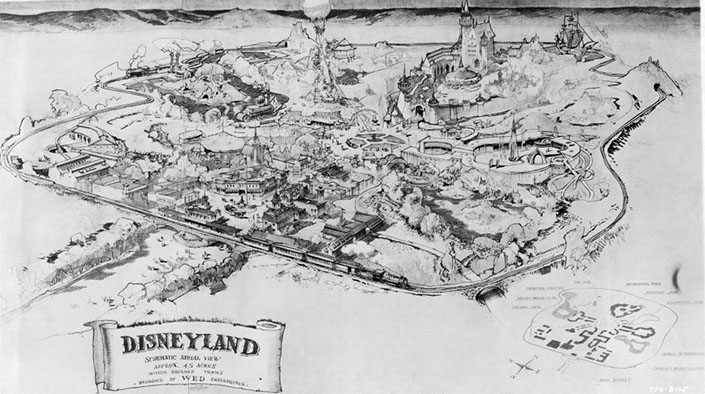
WALT DISNEY'S HOLIDAYLAND
The first ideas for Walt Disney’s Holidayland began October 8th, 1953. Nine and a half months later, construction for the Magic Kingdom of Disneyland, “the Happiest Place on Earth”, began on July 21, 1954, just 12 months before the park was scheduled to open. The staff worked around the clock and bit by bit, Disneyland got ready for Opening Day. Six thousand invitations had been sent out for the Grand Opening and by mid-afternoon 28,154 ticket holders had flooded Disneyland and most of the tickets were counterfeit. Walt agreed to produce a regular television show for ABC in return for funding. 90 million people watched the opening on ABC television.
Disneyland opened in Anaheim California on July 17th, 1955 during a 110 degree heat wave. Disneyland initial budget was to be $9 million dollars on 45 acres and by opening day had grown to $17 million dollars on 160 to 180 acres.
Attractions on Opening Day
Main Street, U.S.A.
Adventureland:
Jungle Cruise
Frontierland:
Davy Crockett Arcade
Frontier Trading Post
Golden Horseshoe Revue
Mark Twain Riverboat
Mule Pack
Stage Coach
Fantasyland:
Canal Boats of the World,
King Arthur Carousel
Mad Tea Party
Merlin’s Magic Shop
Mr. Toad’s Wild Ride
Peter Pan’s Flight
Sleeping Beauty Castle
Snow White’s Adventures
Tomorrowland:
Autopia
Circarama, U.S.A. (playing “A Tour of the West”)
Clock of the World
Monsanto Hall of Chemistry
Space Station X-1
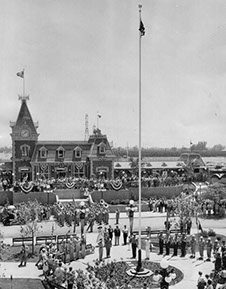
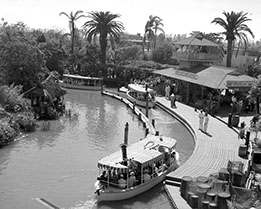
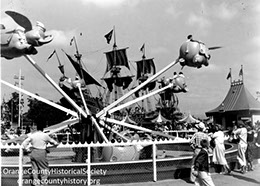
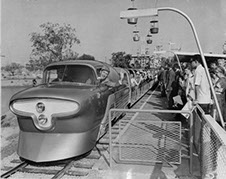
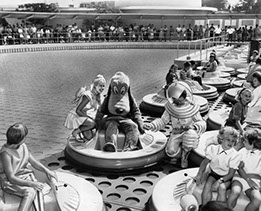
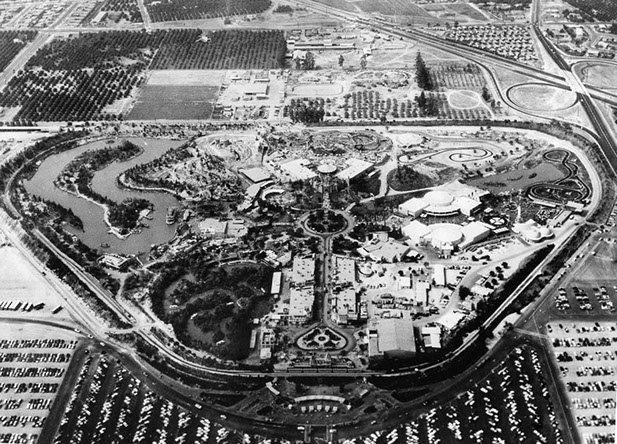
Disneyland
When Disneyland opened it charged visitors $1.00 admission, or about $6.50 in today’s dollars, to enter the park and see three free attractions in four themed lands. Individual tickets for the 18 rides cost 10 to 35 cents each.
Disneyland ultimately limited daily attendance to 20,000 to avoid overcrowding. Within seven weeks, on September 8th, the one-millionth guest passed through the gates.
Despite cost over-runs Disneyland turned a profit in its second year and ten years later had averaged 5 million guests per year. By 1985, 30 years after opening, 250 million people had been to Disneyland and by 2004 Disneyland had its 500 millionth guest. With all of the theme parks built Disneyland still ranks number two in annual attendance behind the Magic Kingdom in Florida.
At a forum on the future of themed entertainment at the International Association of Amusement Parks and Attractions tradeshow in 1997 Bob Rogers the founder of BRC Imagination Arts and Harrison “Buzz” Price spoke on the “Coming Revolution in Themed Entertainment”. Bob Rogers stated that Walt Disney ignored conventional wisdom and reinvented our business and that the time has come again.
Buzz said that before Walt came along, the entire industry was getting one dollar per capita, per guest visiting the park. Walt figured out how to get $4.50 per cap in the first year of operation at Disneyland and $6.00 per cap by the second year. Disneyland accomplished this by extending the length of stay. The previous average stay time was less than two hours and by creating a pleasant and refreshing environment Walt achieved an unheard of seven hours and when he did the per caps on food, retail and ride tickets went up.
Disneyland was the first place created, not by architects and engineers, but by storytellers. Walt focused on the people putting the guest experience first.
Buzz Price founded Economic Research Associates (ERA) in 1958 largely due to Walt Disney’s encouragement and offering of a three-year contract for research time.
Today ERA is an internationally recognized consulting firm that specializes in all aspects of real estate and land use economics, planning and development economics, resource economics, recreation economics, strategic planning, and management and marketing services.
The most recently built projects of Disney and Universal have budgets that have far exceeded $1 billion dollars each. During the concept design of these projects the ‘Rule of Thumb’, as stated by companies such as ERA and used as a starting point for design, was $100 per head times the yearly attendance. In other words, with a park such as EPCOT and an anticipated yearly attendance of 10 million people, the warranted budget is $1 billion dollars.
Islands of Adventure opened in 1999. Tokyo DisneySea, California Adventure and Universal Studios Japan opened in 2001. Disney MGM Studios Europe opened in 2002.
Unfortunately with the opening of these most recent parks the factors have more than doubled the respected guidelines and today nearly ten years later, the comments from Bob Rogers and Harrison Price couldn’t be more concerning.
A current project in the United Arab Emirates was recently costed out at $1.4 billion with an anticipated yearly attendance of 2 million people. This raises the rule of thumb by a factor of seven.
Whatever reasons account for this trend, the outcome severely challenges our industry. For years ‘reinvention’ has been tossed around as casually as terms like ‘virtual reality’ and ‘interactive’ were before they existed.
Today we have many more solutions available to designers through cost-saving construction techniques, proven ride and show technologies and a current appreciation of program integration and synergies allowing shared budgets, yet we are having an impossible time in encouraging the viability of potential projects.
Disneyland was built despite many challenges, in one year inclusive of mountains, monorails, flying saucers, submarines, jungles, etc. when little or no construction expertise existed. Current projects take nearly 4 to 5 years to construct.
The masterplan effort of new and major theme parks has taken more than a year in just the development of acceptable placemaking.
Billion dollar budgets are casually discussed outside of the major branded opportunities. There is a perpetuated aura of legitimacy attached to proposed big budget projects. It appears to have become an act of doing business and is damaging to the health of our industry. Delays are perpetuated to draw out the process and short term financial opportunities.
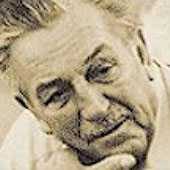
MASTER PLANNING
Entertainment master plan solutions are not arbitrary. The economic study informs the planning process recommending attendance levels and warranted budgets, as well as general overall sizing. Master planning is an exploratory exercise ultimately defend-able when all design issues are carefully considered. The design program and scale, operations, site analysis, constraints diagrams, synergies, cultural considerations, and the mission statement / goals and guidelines are thoroughly considered and to a large degree allow the site master plan to present itself.
Placemaking and storytelling is paramount in presenting design intent. Great ideas can be easily discarded if not presented in an accurate professional manner. Honest key art can be captivating and responsible for project approvals. Illustrated elevations and sections can serve as key presentation art in addition to establishing a sense of scale, providing valuable information to build consensus and inform costing ensuring budget confidence at early stages of design. Thematic development of each land within a theme park, each resort hotel, the entertainment retail and dining destination, the water park, other attractions, etc. must be reflected in the initial detailed master plan to effectively represent and accommodate design direction. To live in the diagrammatic ‘bubble stage’ too long is a noncommittal waste valuable time unless the bubbles are entirely informed.
Economic Study
The scale of any project is determined based on local demographics and penetration rates informed by the economic study. It’s important to determine the design day/peak-in-park attendance levels to which attractions, food and beverage, retail, guest services, back of house, etc. are carefully tailored to. Access, parking and instantaneous capacities are determined based on peak day/peak-in-park attendance levels because if you can’t park them you won’t get them.
Annual and seasonal attendance patterns are the two major factors that determine appropriate sizing of theme parks and water parks. Where a theme park is a year-round attraction, based on weather issues a water park is considered a seasonal attraction with an operating season of approximately 120 days.
Based on the local demographics the theme park yearly attendance is determined. The peak month is typically considered to be 15 percent of the yearly attendance. The peak week is based on 4.35 weeks per month and the peak day within that week is determined to be 25 percent of the peak week attendance. 70 percent of the day’s visitors will be on site at the same time and should be considered the Design Day attendance that the theme park attractions should be planned. The theme park is generally sized to the design day peak-in-park attendance and should be approximately 450 people per acre including attractions and guest circulation.
Experience at numerous theme parks reveals that for a peak day visitor to enjoy the theme park he must experience approximately 1.7 attractions per hour. Percentage of guest arrival by car, bus, train or other is determined by the economic study and based on local site demographics and accessibility. Car parking spaces are determined by the study and may normally be 3.5 persons per car and sizing is generally determined to be 125 cars per acre.
Based on the length of the operating season, a water park typically is expected to generate 30 percent of its attendance in one peak month. There are 4.35 weeks per month and an average peak weekend design day is roughly determined to be 22 percent of the peak week. The peak-in-park attendance anticipates that 65 percent of the visitors on design day will be in the park at any one time. Once the design day is determined a rough figure of 400 people per acre accounts for the attraction space required including attractions and guest circulation.
Programming
Retail, Food and Beverage
Theme park operating margins are reliant on the yearly attendance and per capita expenditures. Per capita revenues vary based on cultural and demographic differences where income generated by food, beverage and retail can vary between approximately 40 and 55 percent. It is critical to make accurate programmatic decisions during the initial master planning phase of design. These decisions can prove crucial for a theme park and the entertainment retail and dining components of any project providing the maximum results during the first years of operation and the ultimate success of a project.
Food and beverage concerns include a careful balance of restaurant, buffeterias, fast food, walk-ups and assorted food carts. Food and beverage sizing relates to the design day peak-in-park numbers and the determination that everyone in the park will want to eat within a three to four hour period around mid day. Sizing is based on and understanding demand. An understanding of the demographics will determine the number of restaurant seats versus buffeterias seats versus fast food seats. Typically a restaurant will have 1.2 turns per hour, buffeterias will have 1.8 turns per hour and fast food may have between 3 and 4 turns per hour. Walk ups which are just small fast food facilities require only a few seats or benches for comfort and are normally positioned along the primary walkways. Level of service, quantity of seating and a balance of indoor and outdoor seating all have an effect on thoughtful space planning and must be considered in the early stages of master planning. Walk-ups and food carts as well as retail carts must be considered as permanent facilities and utility connections will determine viability in most cases and cannot easily be dealt with as an afterthought.
With the qualities of branded rides and attractions there is an effect to the master planning. Until recently a general rule of thumb was that approximately 55 percent of the total retail would exist at the main entry street with the balance carefully distributed in key locations throughout the park. Retail sizing is based on the yearly attendance and per capita retail spending. This dollar amount is divided by an understanding of anticipated retail square foot revenues giving you an amount of front-of-house retail requirements. Retail planning is typically laid out at 50 percent circulation and 50 percent display. Additionally a determination must be made for the quantity of on-site merchandise storage which will account for a daily need to replenish stock on peak days. You never want to see barren shelves.
Today with the major parks like Disney and Universal, quality branded attractions and localized branded retail per capita spending has increased affecting the required scale of retail square footage and distribution. This is causing numbers in some cases that are as much as 5 times the maximum retail per capita that has ever been experienced before. Retail and particular branded food and beverage items must be more carefully considered to capitalize on impulse buying and add-on spending. There will always be the need for a quality ‘exit-retail’ store but the location of the balance of the retail is crucial during the master planning stage.
Queue Lines
There have always been excessive space allocated for queues of various sort including; indoor air-conditioned, shaded and cooled, simply shaded and overflow. At between 7 and 10 square feet per guest and a need for between 30 minutes and in some cases 1-1/2 hours of individual attraction queue, the space and costing requirements can been considerable and if not dealt with respectfully can result in an inferior guest satisfaction.
Attraction throughput dictates the number of attractions in a theme park aiming at approximately 1 to 2 attractions per person per hour on average based on the design day peak-in-park. A high quality highly themed park will typically have more expensive attractions to meet guest expectations and defend admission costs. Today some high end attractions budgets can range between $120 million and $180 million dollars each. With major parks and an overall theme park budget of maybe $1.2 billion you can begin to see the challenges and understand why every aspect of sizing is so important. To add more attractions can exceed a budget. To reduce the warranted budgets for each attraction in favor of more attractions can minimize the guest experience and overall quality of the park. Hourly capacities of the attractions are normally pushed to their limits and still guests can find themselves in long waits in uncomfortable environments. This aggravates efforts to increase the length of stay which is responsible for the highest level of per capita spending.
There is an effort today aimed at a better guest experience reducing wait times for not just attraction queues but the entire theme park experience including vehicular access and the arrival/ticketing experience. Technology is making progress that to date is proving to be a bit challenging. Years ago theme parks started up-charging guests selling fast pass tickets allowing guests to move to the front of the line of attractions, in some cases almost entirely missing any developed pre-shows. Utilizing new technologies guests are issued the equivalent of bracelets that allow guests to effectively make reservations for key attractions reducing wait time while also saving money and space on constructed queue lines. Theoretically this also inspires more time to spend in retail stores and food facilities.
As technology has improved and people today are more and more comfortable with smart technologies, there are new opportunities to improve the guest experience. Ticket booths and queuing, auto toll booths and car staging and even access roadways are all being studied to incorporate and integrate smart technologies meant to expedite the guest arrival sequence. Determining the best approach in managing these new operational considerations has an effect throughout the entire master plan.
Attraction Expansion
Expansion sites within the park must be considered and accounted for in the earliest phases of design. Typically the expansion sites are in the buffer zones between ‘lands’ allowing for expansion in either direction and relative either adjoining lands. Where we may already have a good idea of a land theme and a strong future attraction relative that themed land, we will incorporate expansion area or even the footprint of a specific attraction that may already be in design. No matter what we think we may know typically these sites are utilized but rarely for what they were initially intended. These expansion sites must also consider branded retail facilities, new food and beverage and additional guest services and back of house support.
Special Events
Parade routes and support facilities must be considered during the master planning process. This includes the nighttime spectacular which should accommodate the highest viewing capabilities possible, meaning thousands of people, as this attraction is aimed at increasing the length of stay and therefore per capita spending. Area circulation and plazas are critical and must be evenly distributed throughout the park with terracing and optimal viewpoints. This nighttime experience most often incorporates fireworks and pyro which means a pyro storage facility is necessary. This can represent a problem in some cases as the pyro bunker needs to be appropriately place for safety concerns and requires a buffer of hundreds a feet diameter to facilitate accidental discharge or failure. The parade requires a parade route, staging and storage and additional dedicated plaza areas for breakout daytime and nighttime shows. The parade route ideally works its way to a finale down the main street, which serves to draw people to the exit points at the end of the day accommodating a clearing of theme park guests at closing.
Back of House
Effective back of house design requires an intimate relationship with the operations group both during the start up of the design and planning effort as well as ongoing points throughout the design process. The operators must be involved to avoid necessary changes later on. The operators will ultimately inherit the park and will be tasked to make it work effectively. The sizing, location and synergies of all back of house facilities are critical. This includes in-park support required any time a restaurant or buffeteria is positioned as an ‘island’ effectively disconnected from the back of house service road. Service gates, yards and routes must be incorporated when a food facility is isolated as a standalone facility within the park. These are usually waterfront features within key locations affording some of the most beautiful views of the park. As desired as they usually are they must be very carefully considered and minimized if possible. This can be problematic to the maintenance and upkeep of themed guest circulation routes and cannot be casually considered.
Facility Sizing
A shocking reality when working to program is in clearly understanding the up-sizing necessary of all themed and non-themed facilities alike to account with the thickness of themed construction as well as critical space required within facilities for support circulation and access. The support of retail and food facilities as well as guest services requires movement for employees and support that is done off stage and never through the front door. A casual notion of underground access can result in budgetary problems that can ultimately be disregarded simply due to cost over runs even in high end theme parks. This requirement can result in a plus 30% effect to all program sizing requirements. Guest flow sizing in retail facilities is normally considered at 20 square feet per person. This accommodates circulation and interaction with merchandise.
Design should always consider guest access. Typically we have double wide entry doors that remain open even in hot climates so as not to discourage guest access. Doorways are ideally angled directed at the guest flow and rarely are set parallel to the guest circulation. This creates a slight add to required square footage but is critical to per caps. Additionally we don’t typically theme out the entire ceilings of the indoor spaces with the exception of entryways and above point of sale areas as we want to focus budget on exhibitry of product. In some cases at high end parks the retail and food facility interiors are entirely themed but more often we will expose all ceilings and ducts in this process and typically paint the ceiling dark, rarely black and normally a dark purple or blue making the feel less heavy and a little more fun and acceptable.
Instantaneous Capacity
Before a master plan can be committed to it is important to track the instantaneous capacity with a goal to meet the peak-in-park of the design day. As an example, the original expectation for Universal Studios Japan was to open at 8.5 million guests per year and grow to 12 million. As the master planner I was concerned with the numbers I was aware between Disney World in Orlando and the attendance hike that Disney experienced in Tokyo. When I looked at Universal Studios Florida and compared the same percentage hike to Osaka, Japan, my concern was that we could hit higher levels of attendance. The program was not debatable but the instantaneous capacity guest circulation was within my control.
To ultimately size a park you can consider that all food facilities will be occupied at approximately 105 percent. This accommodates for every seat being filled and an additional 5 percent of people looking or waiting for seats. Overall retail program can be reduced by 50 percent accounting for display and as I’ve said the guest area can be measured by 20 square feet per person. Attractions have an instantaneous capacity which includes all queue areas, holding areas, pre-show areas, and load and unload stations, seating which can vary drastically depending on roller coasters with maybe 96 seats versus theaters with higher instantaneous capacity of as high as 2000 seats. Even restrooms account for an instantaneous capacity as well as all guest service areas. The instantaneous capacity for guest walkway circulation throughout the park can be measured at 20 square feet in common areas and 40 square feet in secondary, less trafficked areas. Additionally, it is important to understand that the main street area will not be as dense with guest as the attraction areas and should be slightly discounted for an effective study. When totaled up and compared to the design day peak-in-park adjustments can easily be made in circulation widths. This can mean a lot in the guest satisfaction levels and the park’s ability to flex when peak-peak days come along. These peak days can account for some of the highest revenues, but guest must be accommodated in comfort. When the crowds become too dense facilities become less visited and start to fail when you need them most.
It’s important to understand that food program ideally travels with the guest instantaneous capacity. So it is important to realize that the attractions instantaneous capacities need to be evenly weighted across the site. The park should be considered a sponge and needs to absorb guests evenly for maximum performance. If attractions with high capacity or with maybe a 2000 seat theater dumps, the guest circulation must effectively absorb the large capacity hit. This cannot be compromised by additional high rated attractions in the same vicinity. Facilities will fail to perform and bottlenecks will form.
To prepare a competent master plan for Universal Studios I fortunately provided more circulation as Universal Japan’s yearly attendance has grown to over 14 million guests in recent years. Yes this was due to expansion attractions but the higher numbers were hit earlier than anticipated and guest access and flow to the expansion sites were critical to the park’s overall performance.
Budget and Schedule
We are always working to a budget and design schedule. It’s safe to consider that we are over budget and out of time as that day will always come. Facing this fact sooner than later is always the safest approach to design. Costing out design is paramount and during the early phases a clear understanding of related construction costs is necessary to avoid under or over designing the project which can cause costly changes and schedule creep affecting every step of design. The primary focus is to put as much of the budget in the guests eye and creating a seamless more inviting experience than ever before.
Observations
Theme park budgets are constantly increasing as are the design schedules which both are unacceptable. There are design ‘rules of thumb’ that we have effectively employed over the years that have changed dramatically in recent times as new technologies and guest expectation has increased. One rule of thumb based on many major projects built over the years suggests that a warranted budget that meets all expectation is ‘$100 times the yearly attendance’ or in other words if there is an expectation of 10 million guests per year then the budget should be expected to be approximately $1 billion. This number has more than doubled in recent times.
New park designs and boundaries are growing, becoming bigger than ever. Attractions are becoming ‘environmental’ with more outdoor themed areas and growing costs. The ’rule of thumb’ for attractions used to be $1000 per square foot. This trending expansion in design carries hidden costs when infrastructure, landscape, area development, utilities and the overall utility loop are realized. Shade control beyond the main street retail component is becoming an expectation and ideas for park coverage or shelter aimed at increasing operating schedules, is becoming a design and cost factor.
Today it is not unrealistic for a new land in an existing park to border on $450 to $500 million dollars. It’s not unusual for a single new attraction to be over $200 million dollars. New construction techniques used in themed facades have helped to reduce costs but design costs have increased. Schedules are also abbreviated in an effort to reduce costs. It’s an on-going challenge to meet guest expectation in an increasingly competitive environment.
INCITES
DAMRON DESIGN
WE'D LIKE TO SHARE
*
Remember too keep the QUICK ACCESS, LANGUAGE and LOCATION BAR closed, before you preview/publish.
You can click on the bars to edit the content inside the expandable menus, and when you are done you can click again on the bars to close them.
*
Close the menu bars before preview/publish. That way you can make sure that they will not block the content on other pages.
To close, select the menu and uncheck the option that says: "Show lightbox parts while editing" .
To edit the menu bars again, you can check the same option and the submenus will show up.
Damron Design LLC is an Entertainment Design Company with experience in development of concept design and leading project design and master‐planning of theme parks, water parks, entertainment dining & retail, resort hotels and themed environments around the globe. our core strengths are in design, programming and master planning large-scale developments, leading design of branded entertainment, attractions and resorts, managing economic and feasibility concerns, controlling design direction relative cost and budgets, and developing and managing design core teams to realize project potential.







